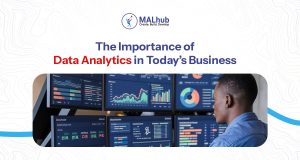Data analytics using artificial intelligence (AI) improves the application of AI to the analysis of massive data sets. Most organisations are shifting to artificial intelligence (AI) as data grows exponentially to derive actionable insights from massive datasets. AI is changing how data is analyzed, revealing patterns, improving processes, and enabling smarter decision-making. In this article, we’ll explore seven unique ways AI is used in data analytics and show how professionals can prepare for a future in this growing field.
Why AI is Transforming Data Analytics
AI is changing data analytics by enabling the automated analysis of large, complex datasets, allowing businesses to extract valuable insights much faster and more accurately than conventional methods, leading to better decision-making through pattern recognition, predictive analytics, and the ability to handle unstructured data, all while minimizing human intervention in repetitive tasks.
AI decreases manual effort, enhances precision, and shows patterns that humans might miss. Data analysts are still expected to be in high demand, as AI technology is not used to replace analysts but rather provides them with the assistance they need to do their jobs better.
MALhub, with its Data Analysis Virtual Training, trains learners to use these AI-driven tools, making data analytics accessible and actionable even for those new to tech.
7 Unique Ways to Use AI in Data Analytics
1. Predictive Analytics
AI-powered predictive analytics enables businesses to forecast outcomes by analyzing historical data. This helps organizations predict trends, optimise strategies, and distribute resources effectively.
Predictive models are widely used in industries such as finance, healthcare, and retail to improve decision-making. These tools analyze factors that influence future performance, allowing businesses to make proactive adjustments and stay competitive.
2. Natural Language Processing (NLP) for Text Analysis
Natural Language Processing enables computers to interpret and analyze human language. NLP is used in data analytics to process and glean insights from massive volumes of text-based data, including emails, social media posts, and customer reviews.
By analyzing sentiment and identifying key themes, businesses can optimize marketing strategies and improve customer satisfaction. NLP’s ability to process unstructured data adds immense value in industries such as e-commerce and healthcare.
3. Anomaly Detection
AI is effective at identifying irregularities in datasets, which is important for detecting fraud, preventing cybersecurity threats, and improving operational efficiency.
By continuously monitoring data streams, AI can detect suspicious activities, ensuring prompt action is taken. This makes anomaly detection a vital tool for businesses aiming to maintain security and operational integrity.
4. Automated Data Cleaning
Data cleaning is an essential yet tedious task. AI automates this process by detecting and correcting errors, removing duplicates, and filling in missing values.
With clean, accurate datasets, businesses can perform analysis with greater confidence and efficiency. This automation saves time, reduces human error, and ensures that insights derived from data are reliable.
5. Recommendation Systems
Recommendation systems personalize user experiences by analyzing data on preferences and behaviours. These systems are integral to platforms in e-commerce, streaming services, and online education.
By tailoring recommendations to individual users, businesses can enhance customer engagement and drive sales, making recommendation systems a cornerstone of modern analytics.
6. Image and Video Analysis
AI’s ability to analyze images and videos is transforming industries such as healthcare, marketing, and manufacturing. In healthcare, for example, AI assists in diagnosing conditions by analyzing medical imaging, while marketers use AI to measure the effectiveness of campaigns through video analytics.
The potential applications of image and video analysis continue to expand, offering opportunities for professionals skilled in this area.
7. AI-Driven Data Visualization
AI-powered visualization tools simplify complex datasets, enabling stakeholders to grasp trends and make informed decisions quickly. Interactive dashboards and visual storytelling ensure data is presented in an engaging, easy-to-understand format.
These tools are indispensable for business leaders who rely on real-time insights to shape strategy and monitor performance.
Check out this article on The Future of Work: How Automation and AI Will Change the Job Market to learn more about how AI will shape job opportunities and skills in the years to come.
Future Trends in AI and Data Analytics
The integration of AI and data analytics will deepen in the coming years, with advancements including:
- Automated Insights: AI will increasingly generate insights with minimal human intervention, democratizing access to analytics.
- Natural Language Querying: Users will be able to interact with data using everyday language, making analytics more accessible to non-technical professionals.
- Enhanced Data Security: AI tools will strengthen data protection by identifying vulnerabilities and mitigating risks in real time.
These trends highlight the relevance of acquiring AI-driven data analytics skills to stay ahead in a competitive job market.
Start Your Career in Data Analytics with MALhub
MALhub offers a 12-week Data Analysis Virtual Training tailored to equip learners with essential skills for a career in data analytics.
What You’ll Learn in this Course:
- Master tools like Excel, Power BI, Python, and SQL.
- Gain lifetime access to resources worth over ₦350,000.
- Receive a free Microsoft 365 subscription for one year (₦64,000 value).
- Build a portfolio with real-world projects.
- Get certified and mentored by industry experts.
Program Details:
- Start Date: January 28th, 2025
- Fee: ₦70,500
- Register Now: MALhub Data Analysis Course
Conclusion
AI is changing data analytics by making insights more accessible, accurate, and actionable. By using tools like predictive analytics, NLP, and data visualization, businesses can optimize operations, enhance customer experiences, and drive growth.Are You Ready to transform your career in 2025? Join MALhub’s Data Analysis Course and prepare to make an impact in 2025.
















